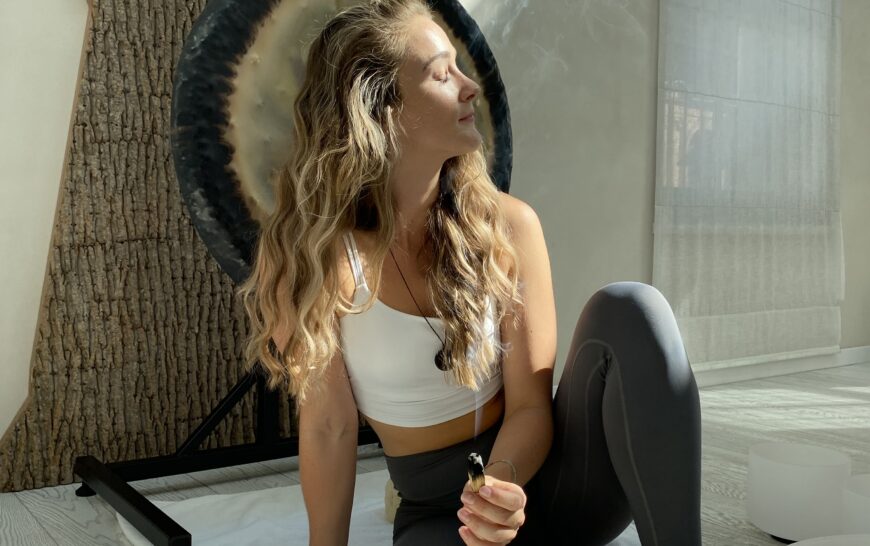
This is a guest post with Jasmine St Cliere for content pitches please email contact@zoella.co.uk
Breathing is the very first and last thing you do in this world, in this body of yours. Something we have in common with all other living things on this earth, is that in some way, the breath is present. The action of breathing itself is involuntary, meaning our bodies are capable of doing it without conscious thought. What I am fascinated by is what happens when we do give it the power of thought and become interested in the intention.
How should I be breathing?
This is breathing we want to be doing to avoid brain fog and fatigue and to provide our cells with the optimal amount of oxygen to carry out day-to-day tasks. Jasmine St Cliere
Ideally, we are looking to be breathing in and out through our nose the majority of the time. Nasal breathing filters the air as well as slowing down the rate at which we bring it into the body. Functionally, we want to be breathing out and wide into the thorax, utilising the space within our rib cage and the full depth of our lungs. This is breathing we want to be doing to avoid brain fog and fatigue and to provide our cells with the optimal amount of oxygen to carry out day-to-day tasks. The versatility of Breathwork makes it accessible as a form of meditation, right through to enhancing athletic performance and everything in between. By learning different techniques and how to adapt the breath, we can create physiological shifts, using this to energise, to calm or to assist in deep soulful healing.
The Intelligence of the Breath
The amazing truth about the breath, is that it is able to ride the full spectrum of our autonomic nervous system. Every breath in is an activation, an acceleration and every breath out is a deactivation, a deceleration. Humans are capable of this amazing process called co-regulation, meaning that neurotransmitters in our brain are able to subconsciously recognise the state of others around us, causing us to shift our internal system, as we begin to sync. The breath is one of the factors that governs that. The speed, rhythm and depth of how others around us are breathing, can communicate the physiological state that a body is in. Our systems begin to match to the quality of breath around us, as our nervous systems interact and start to calibrate.
We may not even notice that we shift into this style of breathing, but our bodies are reading off one another and often copying.Jasmine St Cliere
This of course has its advantages and its disadvantages. If we are on the tube at rush hour, for example, many commuters will be in a mild anxious state from either work pressure, transport delays, the loud noises etc and this can cause stress-induced breathing. This can be seen in short shallow breaths taken into the upper chest or shoulder region of the body. We may not even notice that we shift into this style of breathing, but our bodies are reading off one another and often copying. We may notice, ‘I can sense I am not breathing much at all right now… and I feel uncomfortable about how many people are this close to me.’ With this awareness, we may then start to breathe a little deeper, perhaps a little slower, to calm not only ourselves but those around us in that setting.
We may also have experienced the opposite, for example being around your favourite yoga teacher seems to relax you when they press down on the tops of your feet in savasana. For you it might be your best friend or a family member, in other words, it’s that person who automatically gives you all the good vibes. They are most probably in a calm, centred and regulated state and being around them causes your system to co-regulate. Our body’s intelligence registers, ‘I like this, I feel good, I feel safe.’ The response is often steady and slower breathing. If there is one way of noticing how safe you feel in your body at any given time, it is the quality of your breath.

Breathing to Aid Stress
In a state of stress, the breath is often the last thing on our minds. Yet if we are to stop for a moment and observe how we are breathing in that state, we may notice the breathing is quick, short or sharp, moving the upper chest, fueling that anxious energy. The good news is, breath awareness is a really effective tool to combat the effects of stress. If we are able to take ourselves away from the stressful situation, to pause for a moment and focus on the exhalation becoming slow and deep, we can stir significant shifts in the brain wave state, lower the heart rate and help us manage unwanted emotions that overwhelm. This slower breathing communicates safety to the body which is a feeling we often need a reminder of in this fast-paced world.
The Healing Potential of the Breath
While functional breathing really is the most important type of breathing, because it is what we do all day every day, there is increasing popularity with Breathwork that brings about deep states of healing.
Holotropic, Transformational and Rebirthing Breath are just a few modalities that stem from the Conscious Connected Breathwork lineage. This is a breathing technique that comes in and out through the mouth in one circular motion, with no pause at either end.
While breathing through the nose is of course what we should be doing in our day-to-day, an active mouth breath can bring about a clear connection with self, altered states of consciousness and deep emotional release.
Jasmine St Cliere
While focusing on an active inhale, this breathing is a healthy stimulation of your sympathetic nervous system, in other words, the part that says ‘let’s go, let’s move’. Which has often been repressed or unable to be expressed in traumatic moments in our lives, however great or small. The breath carries you into a deeply embodied state where you are able to process and integrate what the body needs to discharge or experience, in order to heal.
Remember that while on different parts of the spectrum, trauma can be experienced from nearly being hit by a bus and trauma can be experienced from a severe car accident. Your brain might be able to see perspective but your body cannot, your experience is your experience and we can learn not to compare it to that of others.
The great thing about the breath is that it is accessible to absolutely everyone and you only need yourself to start connecting with it.

3 breathing techniques for beginners:
Whether you are a beginner or not, we can all benefit from simple breathing techniques and sometimes the simpler, the better.
1. Even Breath Count
In this technique, we start to equalise the breath. Most of us naturally have a sporadic breathing pattern, meaning there is no regular rhythm in the way we breathe.
- For this technique start by noticing your breath, how you are breathing
naturally. - Starting to extend the breath, beginning to count 3, 2, 1 as you inhale,
and 3, 2, 1 as you exhale. - Repeat this for a total of 5-10 minutes.
- As you grow in confidence and comfortability with this, you can extend
the breath to 4, even 6 or 8.
2. Two-Part Exhale
Research states that we rarely breathe with our full lung capacity, meaning we take only partial exhales and then as a result can only breathe a sub-optimal inhale.
- Begin by breathing consciously in and out through your nose.
- Taking a normal breath in, as you exhale breathe out emptying 80% of
your lungs. Repeating this until it feels comfortable. - Now taking a breath in, as you exhale breathe out 80% then pause, then
breathe out the full 100% and pause. Repeating until it feels
comfortable. - Lastly, taking a breath in, exhale out 80% pause, exhale to 100% pause,
now see if you can push out an extra 5 or 10% more air. Removing stale air from the lungs. Repeat for 10 more rounds.
3. Two-Part Inhale
Once the lungs are fully emptied we can start to look at deepening the in breath, optimising the lung capacity.
- Begin by breathing consciously in and out through your nose.
- Breathing out to prepare, as you inhale, breath in to 80% full. Then
exhale. Repeating this until it feels comfortable. - Breathing in to 80% then pause, breathing in to 100% and pause. Then
exhale. Repeating until it feels comfortable. - Lastly, breathe in to 80% pause, breathe in to 100% pause, now see if
you can take in an extra 5 or 10% more air into the lungs. Filling the body up completely. Repeat for 10 more rounds.
If you are interested in being guided, Jasmine works with movement, breath and sound, with individuals in a group setting or 1:1 basis.
To enquire about either in person or online bookings please see Jasmine’s website or connect with her on Instagram.




